What is that white stuff?
You wonder as you inspect your mint plant leaves as part of your daily routine.
The most common reason for white spots on mint leaves is a fungal infection called powdery mildew. This causes the leaves to have dust like material sprinkled all over. It does not harm the mint leaves but causes discoloration and affects the taste.
There can be a ton of other reasons to cause these white spots. But don’t worry. I’ve written details of each of these below, so you can get a clear idea of exactly what the issue is and how to go about fixing the problem.
Let’s take a look.
Quick view
| Problem | Symptom | Solution |
| Dust | Dust on leaves | Spray water to clean |
| Iron deficiency | White areas on leaves other than veins | Decrease soil pH using sulfur |
| Magnesium deficiency | White areas on leaves other than veins | Increase soil pH using lime |
| Overwatering | Cause for other mentioned problems | Solution based on problem that it causes |
| Hard water | White layer of salt and minerals on leaves | Clean the leaves. Use distilled water |
| Thrips | White spots on the leaves | Spray water or use neem oil |
| Mealybugs | White spots on the leaves and powdery substance | Spray water or use neem oil |
| Spider mites | White spots on the leaves and thin webs | Spray water or use neem oil |
| Whiteflies | White spots on the leaves and powdery substance | Spray water or use neem oil |
| Aphids | White spots on the leaves and honeydew | Spray water or use neem oil |
| Powdery mildew | White powder on mint leaves | Use baking soda spray |
| White rust | White powdery spots on the leaves | Use bio-fungicides |
| Mosaic virus | White mosaic shapes on the leaves | No solution but to destroy the plant |
| White mold | White fuzzy substance on leaves and stems | Use bio-fungicides |
Environmental
The first thing to check is if the white spots on the mint leaves are because of environmental factors. Many of these are cosmetic and easy to fix.
1. Dust
Maybe your mint leaves are just having some dust. You may live in a location that gets plenty of dust from the roads or construction work in the neighborhood.
How to identify
You can use a damp cloth and wipe the surface of the leaves. If all the dust comes off and the leaves look clean with no marks or discoloration, it’s probably just dust.
Solution
You can use a damp cloth and get the dust off the mint leaves. Or you can spray water on the mint leaves to clear the dust.
How to prevent
If you live in a location that gets plenty of dust, there’s not much you can do about it except cleaning the leaves with water every few weeks.
2. Iron deficiency
Some nutrient deficiencies such as iron or magnesium can cause the mint leaves to turn white.
How to identify
If there’s an iron deficiency in the mint plant, the leaves will turn light yellow or white but the leaf veins will remain green. If this is going for a while, you’ll see some leaves turning black and dying.
There will be no effect if you wipe the leaves with a damp cloth and the white spots will still remain.
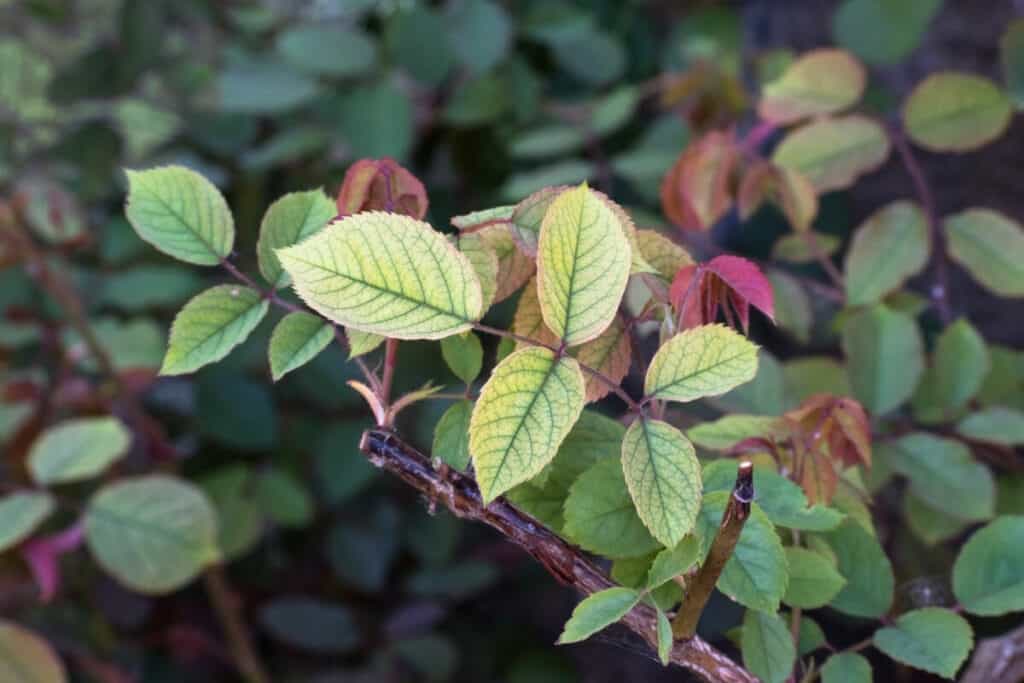
Solution
The problem of iron deficiency usually happens because the soil is too alkaline and the roots can’t absorb the iron from the soil.
Conduct a soil test to find out if this is the problem in the soil. You can add elemental sulfur to the soil to reduce pH and make it more acidic.
How to prevent
It’s best to keep the soil healthy so the mint plant can absorb all the required nutrients from it. I recommend amending the soil every month with some compost that can provide nutrients and beneficial organisms. The compost will improve the soil over time and protect plants from deficiency issues.
I asked fellow gardeners if they have found white spots on their leaves and what was the reason. 75% told that disease like powdery mildew was the main reason causing the white spots. Below are the results of this survey.

3. Magnesium deficiency
Some nutrient deficiencies, such as iron or magnesium, can cause the mint leaves to turn white.
How to identify
If there’s a magnesium deficiency in the mint plant, the leaves will turn light yellow or white, but the leaf veins will remain green. Some leaves will turn black and die if this goes on for a while. If you use a damp cloth and wipe the leaves, there will be no effect.
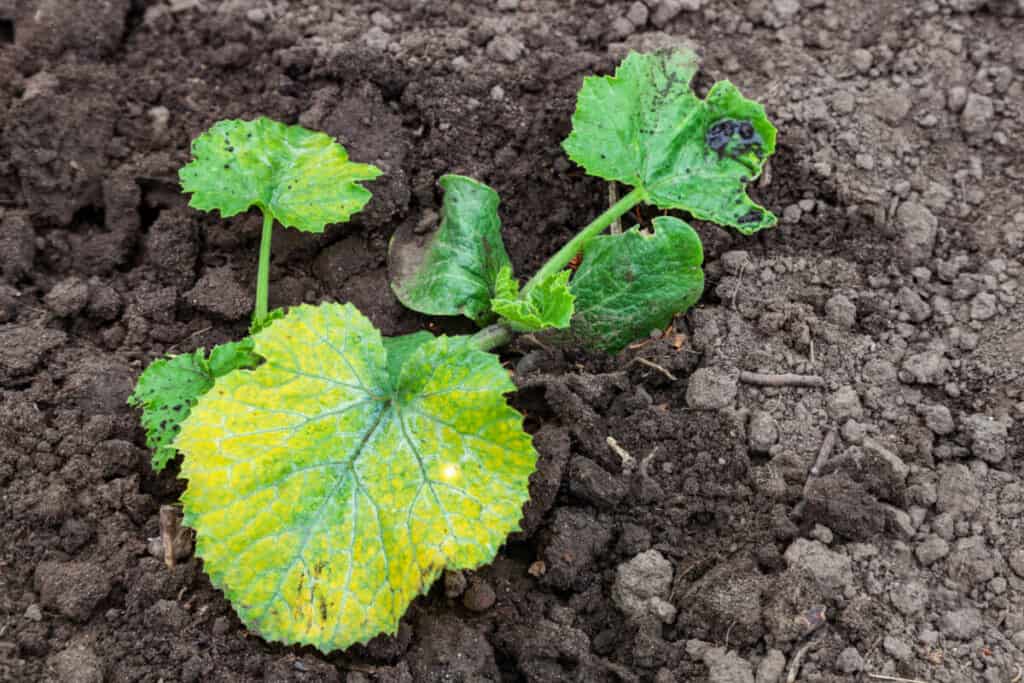
Solution
The problem of magnesium deficiency usually happens because the soil is too acidic and the roots can’t absorb the magnesium from the soil.
Conduct a soil test to find out if this is the problem in the soil. You can add limestone or potassium sulfate to the soil to increase pH and make it more alkaline.
How to prevent
It’s best to keep the soil healthy so the mint plant can absorb all the required nutrients from it. I recommend amending the soil every month with some compost that can provide nutrients and beneficial organisms. The compost will improve the soil over time and protect plants from deficiency issues.
White spots on leaves mostly occur because of the pesticides or it might be the eggs of some insects. If you think it is the eggs of the insects, then try to remove them with some water. If it still appears, then it could be some reactions caused on the leaves because of the insects that fed on those. Highly saturated water could also cause such kinds of spots. If you are using pesticides, then try to replace the items with natural products and check on the salt levels in your water. – Andrew Griffith, Founder at Garden Furniture
4. Overwatering
Overwatering by itself does not cause white spots on the mint leaves. But it can encourage other problems that would cause this.
Overwatering can cause issues such as root rot, nutrient deficiencies, salt or mineral deposits that will cause white spots on leaves.
Overwatering can drown the roots and invite fungal disease on them so they cannot absorb nutrients from the soil, causing nutrient deficiencies.
If you spray water on the leaves often and it’s hard water, the mineral and salt will deposit on the leaves after the water evaporates.
How to identify
Common signs of overwatering are the leaves will turn yellow and may appear soggy. You’ll find the soil soggy most of the time.
If you dig into the soil to check the roots, you may find they are soggy and some of them turning black and smell because of the root rot.
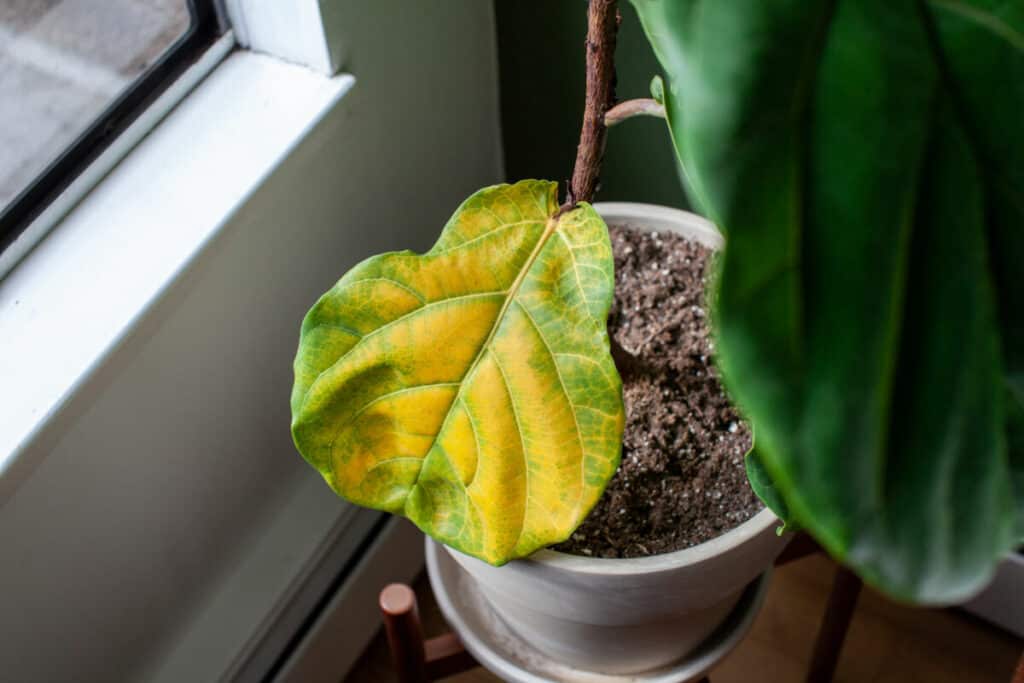
Solution
If the mint plant is suffering from overwatering, immediately stop watering the plant until the soil becomes dry. You can put your finger 1-2 inches into the soil and check if it comes out dry.
You can encourage the soil to dry faster by poking holes with a chopstick so that air can reach into the soil.
Dig into the soil and check if the roots are suffering from root rot and turned black. You need to trim those roots and leave the healthy white/brown ones.
How to prevent
You can prevent overwatering by checking the moisture in the soil before watering it. Stick your finger 1-2 inches into the soil and take it out.
If there is moist soil stuck to the finger, there’s enough moisture and you don’t need to water it. If the finger comes out dry, you can give the soil a good watering.
When watering the plant, I suggest you only water the soil near the base of the plant. Prevent splashing water on the leaves.
5. Hard water
You might be spraying water on your mint leaves when watering the plant or cleaning the leaves. If the water in your area is hard water, it will leave deposits of salt and minerals after the water has evaporated. This will appear as white powder on mint leaves.
How to identify
If you look closely, you should be able to see the salt and mineral crystals on the leaves. You can use a damp cloth to wipe the layer and it should come off leaving clean leaves.
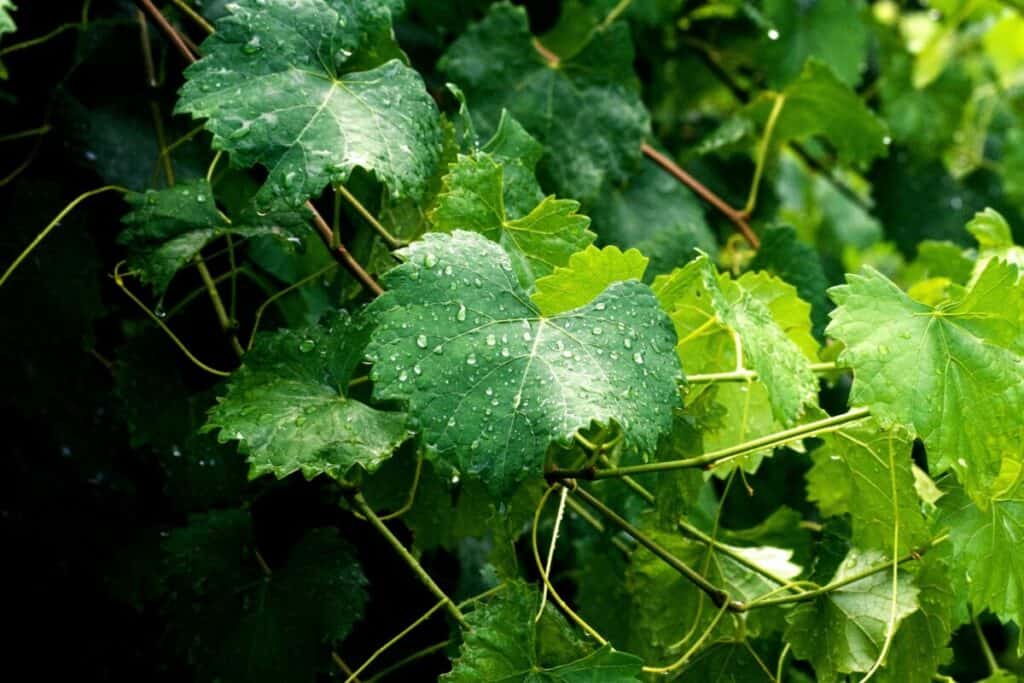
Solution
You can wipe the minerals off the leaves using a damp cloth. You can either use a mister to spray water on the leaves or splash some water on them.
How to prevent
If possible, distill water before using it for watering your mint plant or cleaning the leaves. Otherwise, you just need to clean the leaves every few weeks.
Many issues can cause white spots on plants. Diseases, pests and nutrient deficiencies can lead to white spots on pests. Hard water can also leave behind white spots. This happens when hard water leaves behind minerals, usually calcium, on the leaves. As the water evaporates off of the leaf, the minerals are left behind. – Shelby DeVore, founder of Farminence
Pests
If you find environmental issues are not causing white spots on your mint leaves, the next suspect to investigate are pest problems. Most of these pests are easy to get rid of once you know what the problem is.
6. Thrips
Thrips are small, slender, and long insects that are yellowish, brown, or black. They can fly or leap away when disturbed.
How to identify
Thrips feed on the leaves by sucking the sap, and they leave silvery streaks on them. They are very tiny insects and you may not see them directly on your mint plant. You can use yellow sticky traps to catch the thrips but this would be just to identify you have the problem.
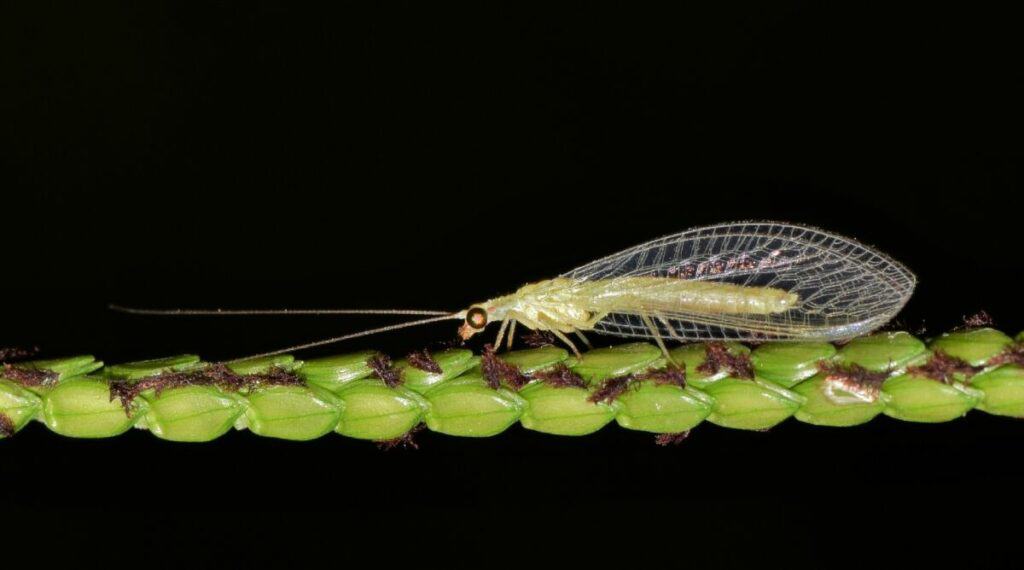
Solution
You can spray horticultural oil, insecticidal soap, or neem oil to get rid of thrips from your mint leaves. You can sprinkle diatomaceous earth on the mint leaves to kill the thrips.
How to prevent
Beneficial insects like lacewings, ladybugs, or pirate bugs eat up the thrips so you can grow plants that attract them.
You can spray the horticultural oil, neem oil, or insecticidal soap every week on the mint leaves as a precautionary measure.
7. Mealybugs
Mealybugs are another sap-sucking pest that are common to edible plants including mint. They suck sap from the leaves and stem of the plant. They are tiny insects that are pinkish but covered by a white, waxy layer.
How to identify
The easiest way to identify mealybugs is to check for waxy white stuff on the undersides of the mint leaves. These are the mealybugs and their eggs.
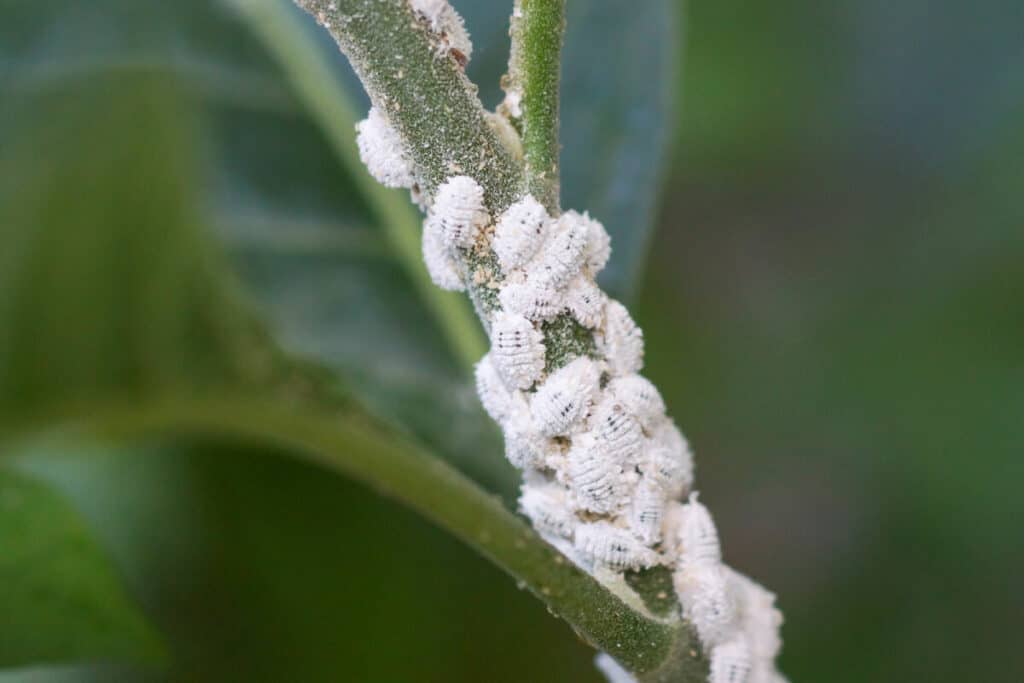
Solution
It’s simple to knock the mealybugs off the mint leaves by spraying water on them. You can also use neem oil, horticultural oil, or insecticidal soap to get rid of them.
How to prevent
I use organic neem oil spray to prevent mealybugs from reaching my plants, including mint. I mix 3ml of neem oil with a few drops of soap in a quart of water. And spray this mixture on all parts of the plant every week.
8. Spider mites
Spider mites are small, 8-legged mites that suck sap from the underside of the mint leaves. They can be yellow or white, and you can see them scurrying around the leaves.
How to identify
You can check for the spider mites, but the easiest way to know is when you see fine webs on the leaves of the mint plant. Check underneath the leaves to find the spider mites and their nymphs.

Solution
The easiest way to get rid of spider mites is to use an organic insecticide made with either horticultural oil, neem oil, or insecticidal soap.
Spray the solution on both sides of the leaves every few days until you see no more spider mites on the mint leaves. You can use a damp cloth to clean up the webs from the mint leaves.
How to prevent
The best way to prevent spider mites is to spray diluted neem oil, horticultural oil, or insecticidal soap every week on the mint leaves to keep them away.
9. Whiteflies
Whiteflies are tiny, white insects that fly around the leaves. They suck the sap out of the leaves and lay their eggs on the underside of the leaves.
How to identify
If the mint leaves having white spots, try shaking the leaves a bit. If there are whiteflies, you’ll see them fly around the leaves.
Check under the leaves and you should find their eggs covered in a white, powdery substance.
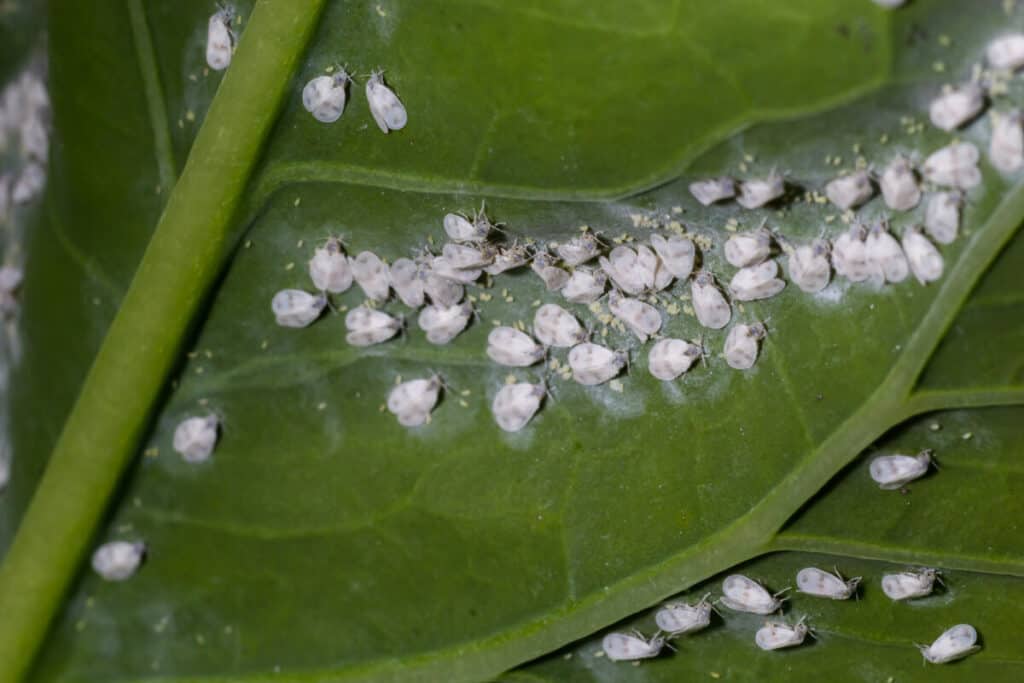
Solution
You can get rid of the whiteflies by spraying water and knocking them off the mint leaves. I prefer to use a spray made with organic neem oil, water, and a few drops of soap to get rid of many pests, including whiteflies. Keep applying it every few days until all the pests have disappeared.
How to prevent
If I find whiteflies often on the mint plant, I use preventive measures of spraying diluted neem oil spray every week on both sides of the leaves to keep them away.
10. Aphids
Aphids are tiny insects that will suck the sap out of the mint leaves. They are one of the common pests you’ll find on edible plants.
They puncture holes in the leaves to drain out the sap and you’ll find those on the leaves as white spots.
How to identify
You can find aphids that are in various colors such as black, green, red, orange, and white. They hide under the leaves and lay their eggs there.
A common sign of aphids is a sticky substance known as honeydew that they produce. It is on the leaves when there is an infestation of aphids.
Another sign is lots of ants roaming around on your mint plant because then collect the honeydew and farm the aphids.

Solution
It’s easy to get rid of aphids once you know they are the issue. Use a spray of water and knock them out of the mint leaves.
I prefer to use a spray made with organic neem oil, water, and a few drops of soap to get rid of many pests, including aphids. Keep applying it every few days until all the aphids have disappeared.
If you can, it’s good to attract beneficial ladybug beetles to the plant as they get rid of aphids pretty fast.
How to prevent
Aphids are attracted to plants that have vigorous growth, so make sure you’re not using too much nitrogen-rich fertilizer.
If I find aphids are reaching my plant often, I use preventive measures of spraying diluted neem oil spray every week on all sides of the leaves to keep them away.
Diseases
If pests are not the issue causing white spots on the mint leaves, the last suspect is a disease. This could be a fungal, bacterial, or viral disease. Some of them could be simple to fix, but some may not have any solution but to get rid of the plant itself.
11. Powdery mildew
Powdery mildew is a fungal disease that affects many edible plants, including herbs like mint. It appears as a powdery, white dots on mint leaves and forms in warm weather and moist leaves.
How to identify
You’ll see white, powdery, substance on your mint leaves that show fungal spores of powdery mildew.

Solution
You can use bio-fungicides such as Bacillus subtilis, potassium bicarbonate, or a spray made with 1 teaspoon of baking soda in a quart of water to get rid of powdery mildew.
Sprays made with horticultural oil, neem oil, or sulfur can also help improve the condition on the mint leaves.
How to prevent
The best way to prevent powdery mildew is to grow a mint cultivar that is resistant to the disease. You should avoid splashing water on the mint leaves when watering the plant. And prune the leaves so there is good air circulation and avoid humid conditions.
You can regularly spray elemental sulfur as a precautionary measure to keep powdery mildew away from the mint leaves.
There are several reasons why white spots may form on plant leaves. One reason may be due to a fungal or bacterial disease called powdery mildew. This disease is caused by a lack of air circulation around the plant, which leads to the formation of white, powdery spots on the leaves. – Harshad Sawant, Indoor Mint
12. White rust
Rust is a fungal disease that infects herbaceous plants, including mint, and causes white or yellow spots. These are the spots that contain the fungal spores.
How to identify
You can identify rust by looking at the leaves, as they will have many white and black spots on both sides of the mint leaves.
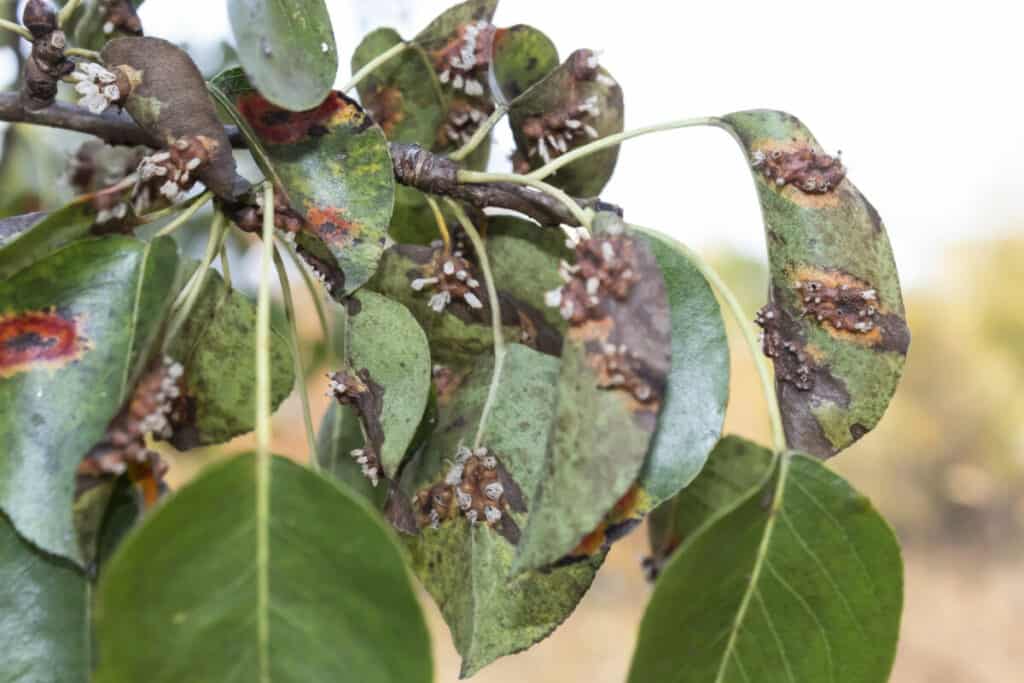
Solution
It’s best to get rid of the affected leaves as soon as you see the problem. Then apply bio-fungicides such as Bacillus subtilis to control the problem and prevent it from spreading if it’s mild. If the infestation is big, you’ll need to dispose of the plant.
How to prevent
You can grow mint cultivars that are resistant to rust. You can also spray elemental sulfur every month to prevent rust from attacking the plant.
13. Mosaic virus
This is a virus that will cause white, yellow, light green spots and streaks on the leaves. It is mainly spread by pests such as thrips or aphids that act as carriers from one plant to another.
How to identify
You’ll see white, yellow, light green spots or streaks on the leaves of the mint plant. Since it’s a virus that affects inside the plant, you won’t see powdery stuff that is common with fungal diseases. You won’t be able to clean it off the leaves.
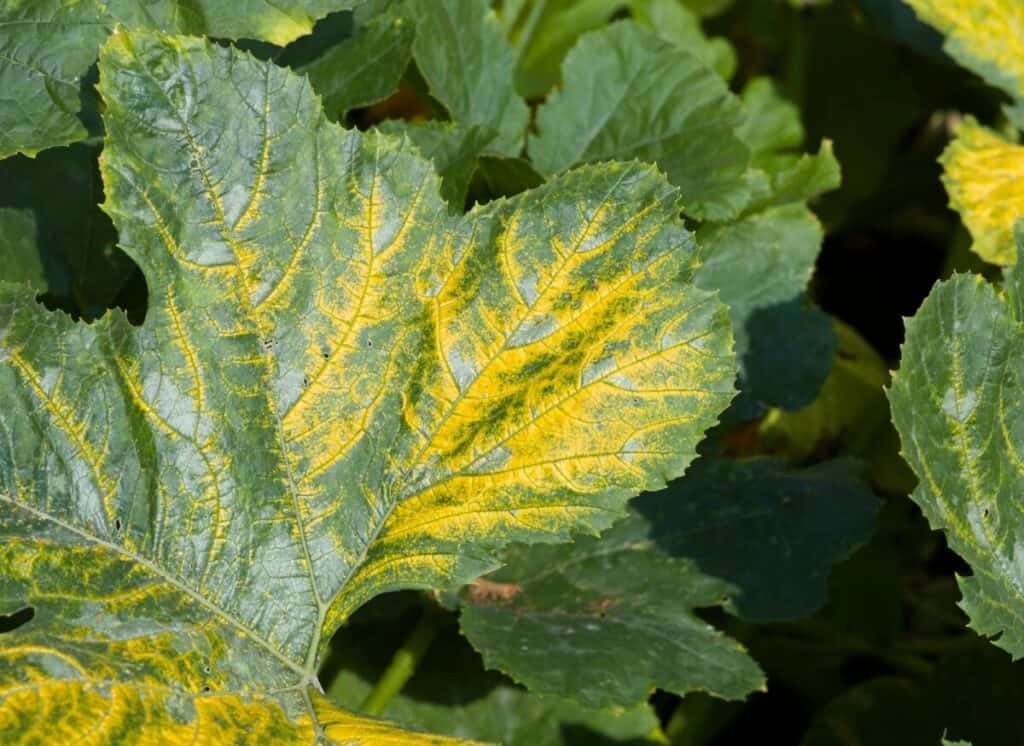
Solution
There is no solution once the mosaic virus affects the mint leaves. You need to remove the plant and destroy it by burning.
How to prevent
You can prevent the mosaic virus in mint plants by growing a cultivar that is resistant to the virus. Since pests carry this virus, you can ensure thrips and aphids stay away from the plants.
So encourage beneficial insects like lacewings and ladybugs. Spray neem oil solution every few weeks to prevent these pests from reaching the plant.
14. White mold (Sclerotinia rot)
White mold is a fungal disease that will cause infection in several parts of the mint plant such as leaves, stem, and even flowers.
How to identify
You will find white mass growing not only on the leaves but also on the stems. There may be water-soaked lesions and wilting as well.
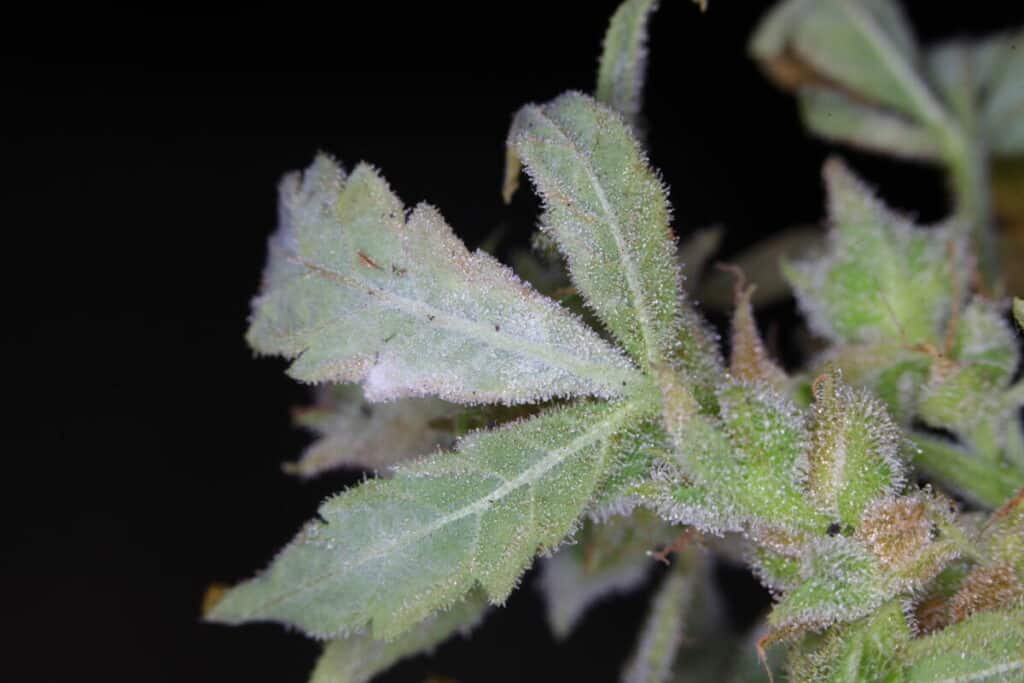
Solution
There are some bio-fungicides, such as Coniothyrium minitans, that will help control the fungus and prevent it from spreading. You need to get rid of the affected mint leaves.
How to prevent
It’s best to grow a mint cultivar that is resistant to the disease. Prevent humid conditions on the mint plant. Avoid splashing water on the foliage and prune the plant for good air circulation.
It’s good to rotate the mint plant with other plants as part of a crop rotation every 2-3 years. So the fungal spores from the soil can become dormant and not infect the plant.
Is it safe to eat mint leaves with white spots?
Ultimately, it’s your choice if you wish to eat the mint leaves that are having white spots. I would suggest to avoid doing that because there’s no need to take the chance.
Fungus like powdery mildew could be wiped off and probably not cause issues. Most plant viruses don’t cause harm to humans, so there would be no need to worry about the mosaic virus that may attack the mint leaves causing white spots.
The white spots caused by pests such as whiteflies, mealybugs, or thrips are cosmetic and won’t cause harm if you consume those mint leaves.
If you choose to eat the mint leaves, give them a good wash so that you take out the fungal spores and impurities that may be on the surface of the leaves.
Sources:
https://pubs.nmsu.edu/_h/H171/index.html
https://sites.udel.edu/weeklycropupdate/?p=13210
https://www.apsnet.org/edcenter/disandpath/fungalasco/pdlessons/Pages/WhiteMold.aspx

Fact Checked, Written, and Published by Kevin Rodrigues
Kevin is the founder of Gardening Mentor, a website that aims to teach people to grow their own food in a limited space. As a self-taught gardener, Kevin has spent several years growing plants and creating gardening content on the website. He is certified in Home Horticulture and Organic Gardening from Oregon State University. He has a Post Graduate Diploma in Horticulture and Landscape Gardening from Mumbai University.
Read more
